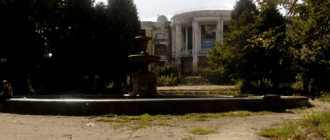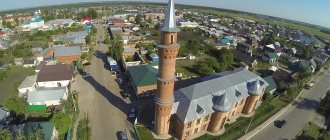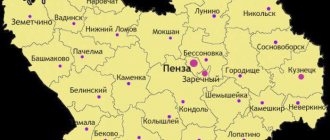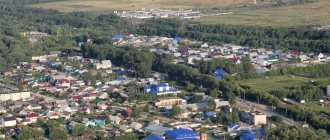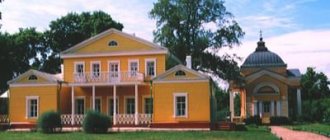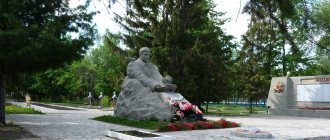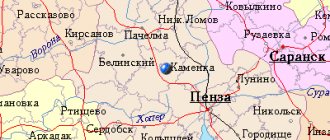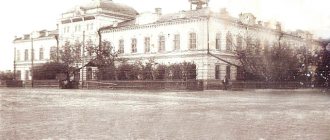Sursk
(Penza region)
OKATO code:
56218508
Founded:
after 1860
Urban-type settlement since:
1928
City since:
1953 City of district subordination (Gorodishchensky district of the Penza region)
The city was formerly called:
| Nikolsky Khutor | 1953 |
Deviation from Moscow time, hours:
0
Geographic latitude:
53°05′
Geographic longitude:
45°42′
Altitude above sea level, meters:
220 Sunrise and sunset times in the city of Sursk
LiveInternetLiveInternet
all posts by the author
How did Sursk come about? There are no legends about this. It is reliably known: the wealthy landowner Astafiev from the Naskaftym volost of the Kuznetsk district of the Saratov province, immediately after the flood in the early spring of 1849, seven miles from his estate located in the village of Turdaki, in a picturesque wilderness on the banks of the Sura, founded a cloth factory. Having free labor - serfs, having there is plenty of building material. Astafiev decided to start a weaving establishment in his patrimony in the manner of those that already existed in the Moscow and Vladimir provinces. In order for the men not to be lazy and to work properly, he promised to give them free rein as soon as the first workshops of the factory were cut down. By the fall of 1849, the premises of the establishment had grown. They installed about ten handlooms, troughs for felling and washing cloth. The factory was ready. It was received by Astafiev himself and his clerks. The master leisurely walked around the workshops, which still smelled of resin and fresh shavings. I checked how the walls were caulked. Doors and frames were adjusted, equipment was installed. The work was done well. No wonder the estate was famous for its carpenters. SURSK, a city (since 1953) of district subordination in Gorodishchi. r-not. Located on both sides of the river. Surahs. 3 km from the railway station. Art. Aseevskaya, 20 km to the north - Gorodishche. Basic in 1849, the landowner Astafiev named Nikolsky Farm as a settlement at a cloth factory. The peasants were transferred from Kuzny. u. In the end 1870s The factory was bought by the merchant A.V. Aseev (see Aseev), who reconstructed it and invested in the construction of the railroad. (nearest railway station Aseevskaya). Aseevsky cloths enjoyed success at the largest Russian markets. fairs In 1880, a school was opened at the faculty, and in 1899, a school opened. Electricity appeared in 1922–26. lighting, running water, a club, a library, and a radio center were opened. In 1928 it was transferred to the category of a town with the name Nikolsky Khutor. In the 1930s The farm and workers' settlement are being expanded and improved. In 1941 the foundry-mechanical shop was founded. plant (on the base of the evacuated Vyshnevolotsk mechanical plant “Proletarian Avant-Garde”). These two avenues are the main ones in the city, which received the name. S. in Aug. 1953. The center of the wool industry of the region (Krasny Oktyabr plant) produces drapes and yarn. The canvas was used for the “Battle of Stalingrad” diarama. In 1992, the plant was transformed into a joint-stock company (see Surskaya Cloth Factory). Foundry and mechanical plant (casting, etc. for the textile industry). Mobile mechanized The column (PMK-60) is engaged in industrial construction. and citizen objects. Business center, clinic, first aid station, pharmacy, 4 schools, 2 recreation centers, 2 clubs, 4 hospitals, sports complex. Monument to the soldiers who died during the Great Ages. Otech. war. The city is richly landscaped, modern. development alternates in its old districts with trees. estates. Homeland of the Hero of the Owls. Union of V.V. Anisimov (a monument was erected). Hero of the Owls lived and studied in Sursk. Union P. N. Emelyanov. To the east On the outskirts there is an ancient settlement (locally called “Pugachev Val”). Population: in 1886 – 175 permanent and 284 registered, 1897 – 829, 1926 – 3566, 1939 – 7326, 1959 – 10879, 1989 – 9902. As of 1/1/1998 – 9700 inhabitants.
Text and photo taken from the site: https://www.sursk.narod.ru/about.html
Place on the map
Map
| Sursk: maps |
Sursk: photo from space (Google Maps) Sursk: photo from space (Microsoft Virtual Earth)
| Sursk. Nearest cities. Distances in km. on the map (in brackets along roads) + direction. Using the hyperlink in the distance , you can get the route (information courtesy of the AutoTransInfo website) | |||
| 1 | Chaadaevka | 14 (39) | NE |
| 2 | Middle Eluzan | 17 (22) | IN |
| 3 | Settlement | 20 (59) | Z |
| 4 | Shemysheyka | 29 (39) | SW |
| 5 | Suitcase | 34 (92) | NW |
| 6 | Russian Kameshkir | 35 (55) | SE |
| 7 | Zarechny | 37 (113) | Z |
| 8 | Zasechnoe | 41 () | Z |
| 9 | Sosnovoborsk | 43 (66) | NE |
| 10 | Penza | 47 (107) | Z |
| 11 | Bessonovka | 50 (125) | NW |
| 12 | Condol | 52 (169) | SW |
| 13 | Lopatino | 52 (84) | YU |
| 14 | Grabovo | 53 (134) | NW |
| 15 | Kuznetsk | 60 (71) | IN |
| 16 | Theology | 61 () | Z |
| 17 | Lunino | 63 (161) | NW |
| 18 | Nikolsk | 74 (120) | WITH |
| 19 | Yevlashevo | 75 () | IN |
| 20 | Neverkino | 76 (105) | SE |
| 21 | Mokshan | 82 (147) | NW |
| 22 | Malaya Serdoba | 85 () | SW |
| 23 | Petrovsk | 87 (133) | YU |
| 24 | Kolyshley | 89 (185) | SW |
| 25 | Baltai (Saratov region) | 92 (143) | SE |
| 26 | Svobodny (Saratov region) | 95 () | SE |
| 27 | Inza | 95 (169) | NE |
| 28 | Nikolaevka (Ulyanovsk region) | 100 (112) | IN |
| 29 | Bazarny Karabulak (Saratov region) | 102 (176) | SE |
| 30 | Bazarny Syzgan (Ulyanovsk region) | 102 (201) | NE |
a brief description of
Located on the left bank of the river. Sura (tributary of the Volga), 3 km from the railway. Aseevskaya station, 92 km east of Penza.
Territory (sq. km): 6
Information about the city of Sursk on the Russian Wikipedia site
Historical sketch
In 1849, the landowner Astafiev, immediately after the flood on the banks of the Sura, 7 versts from his estate in the village of Turdaki, founded a cloth factory. A settlement arose at the factory, which was called Nikolsky Farm. The peasants were transferred to it from the Kuznetsk district. At the end of the 1870s. The factory was bought by merchant A.V. Aseev, who reconstructed it.
In the post-October period, it was officially called Nikolsky Khutor.
Since March 11, 1928, the working settlement of Nikolsky Khutor. In 1953 it was transformed into a city and renamed Sursk due to its location on the river. Sura.
[There is information that it was founded no earlier than 1860 as a farm, separated from the village of Nikolskoye, named after the Church of St. Nicholas the Wonderworker].
Economy
Cloth mill. Alcohol, foundry and mechanical plants.
Main enterprises
TEXTILE INDUSTRY
JSC "Surskaya Manufactory"
442451, Penza region, Gorodishchensky district, Sursk, st.
Nagornaya, 1 Offers:
woolen fabrics, technical
| Population by year (thousands of inhabitants) | |||||||
| 1931 | 4.6 | 1996 | 9.9 | 2007 | 7.1 | 2015 | 6.7 |
| 1939 | 7.2 | 1998 | 9.7 | 2008 | 7.0 | 2016 | 6.5 |
| 1959 | 11.6 | 2000 | 9.5 | 2010 | 6.8 | 2017 | 6.4 |
| 1970 | 10.0 | 2001 | 9.3 | 2011 | 7.0 | 2018 | 6.3 |
| 1979 | 9.8 | 2003 | 8.0 | 2012 | 7.1 | 2019 | 6.0 |
| 1989 | 9.9 | 2005 | 7.5 | 2013 | 7.0 | 2020 | 5.9 |
| 1992 | 10 | 2006 | 7.3 | 2014 | 6.8 | 2021 | 5.7 |
The city of Sursk, Gorodishchensky district, Penza region. Morozko's homeland.
Brief information about the city
Sursk is a city of district subordination in the Gorodishchensky district of the Penza region in Russia.
- The nearest railway stations are Aseevskaya and Kanaevka.
- Located in the same time zone as Moscow and St. Petersburg.
- Population: in the city - 6575 people (2016)
- The city of Sursk is located 78 km from the regional center and 28 km from the district center.
- Telephone city code 84158
- Postal code:442300
- The city car code is 58 (Penza region).
Culture, education and health
- Education: 2 preschool institutions, 2 educational institutions (of which 1 is secondary, 1 is basic).
- Healthcare: JV "Sursk City Hospital".
- Culture: MBUK BDC, library, children's art school.
- Social protection of the population: State institution “Sursky boarding house for the elderly and disabled.”
News from the administration of Sursk
Administration of the city of Sursk: st. Karla Marksa, 1, Sursk, Gorodishchensky district, Penza region, 442300
Tel. (8-841-58) 22-3-01, fax (8-841-58) 22-3-01
Website: https://gsursk.gorodishe.pnzreg.ru
Sursk Map
History of Sursk
SURSK (Nikolsky Khutor), a city (since 1953) of regional subordination. Located on both sides of the Sura River. Area 55 sq. km. As of January 1, 2006 – 7292 inhabitants. 3 km from the Aseevskaya railway station, 20 km north of the city of Gorodishche. Founded in 1849 by the landowner Astafiev as a settlement at a cloth factory, it was called Nikolsky Farm. The peasants were transferred from the Kuznetsk district. At the end of the 1870s. The factory was bought by merchant A.V. Aseev, who reconstructed it and invested in the construction of the railway (that’s why the nearest railway station is called Aseevskaya). Aseevsky cloths enjoyed success at the largest Russian fairs. In 1880, a school was opened at the factory, and in 1899, a hospital.
In 1911 - Nikolaevsky Khutor of the Naskaftym volost, the population consisted of two communities of former serfs of the landowner Astafiev (107 households, 589 inhabitants), church, hospital, factory school, post office, bazaar; the rest of the farm was made up of non-peasant population. In 1922–26, electric lighting appeared, running water was installed, a club, a library, and a radio center were opened. In 1928 it was transferred to the category of a town with the name Nikolsky Khutor. In the 1930s The factory and workers' settlement are being expanded and improved. In 1941, a foundry and mechanical plant was founded (on the basis of the evacuated Vyshnevolotsk Mechanical Plant). These two enterprises are the main ones in the city, which received the name Sursk in August 1953. The center of the region's wool industry (Krasny Oktyabr plant) produces drapes and yarn. The canvas was used for the diorama “Battle of Stalingrad”.
In 1992, the enterprise was transformed into JSC “Surskaya Cloth Factory” (2.5 thousand employees). Foundry and mechanical plant (castings and other products for textile industry enterprises) (700 employees). The mobile mechanized column (PMK-60) is engaged in the construction of industrial and civil facilities (as of January 1, 1993 - 220 workers). Hospital, clinic, first aid station, pharmacy, 4 schools, 2 cultural centers, 2 clubs, 4 libraries, sports complex. Monument to soldiers who died during the Great Patriotic War. The city is richly landscaped; modern buildings alternate in its old areas with wooden estates.
The homeland of the Hero of the Soviet Union, captain, commander of the bomber squadron Viktor Vasilyevich Anisimov (1912-1941), who sent a downed plane to a concentration of enemy military equipment; A monument to the Hero was erected in the city; a street was named after him. Hero of the Soviet Union P.N. lived and studied in Sursk. Emelyanov. The poet Viktor Andreevich Makarov (born in 1935 in Leningrad, lived in Dushanbe) lives and works in the city. On the eastern outskirts there is an ancient settlement (locally called “Pugachev Val”).
Population: in 1886 - 175 permanent and 284 registered residents, in 1897 - 826, 1911 - 589, 1926 - 3566, 1931 - 4598, 1939 - 7222, 1.1.1946 - 9000, 1953 - 12500, 1959 - 1 0879, 1970 – 10145, 1979 – 9825, 1989 – 9902, 1993 – 10864, 1998 – 9700, 2010 – 6802, 2016 – 6515 inhabitants.
Lit.: Grigoriev N.Ya., Silchenko O.M. Sursk. – Saratov, 1980.
Source: Poluboyarov Mikhail Sergeevich, 2007-2011. https://www.suslony.ru
0
How Sursk is returning to city life
In just a year, changes have taken place here that have not been seen for decades.
And even a Ferris wheel!
Sursk is one of those cities where life is built around city-forming enterprises.
For many years, two enterprises set the pace and determined the quality of life. These are the Red October cloth mill and the foundry and mechanical plant. People remember that period with gratitude. “In Soviet times, “Red October” solved all our utility issues,” says pensioner Anastasia Doronina (she worked at the plant as an engineer for about 35 years), “the company’s balance sheet included water wells, treatment facilities, networks, and an asphalt plant.
In the 60–70s of the last century, Sursk was one of the most attractive settlements in the Penza region from an economic point of view.
“The city enterprises were constantly in need of workers,” recalls Viktor Popov (he worked at a foundry), “and people came here with pleasure. Many because of housing. In Penza, for example, factory employees sometimes had to wait 10–15 years for square meters, but here you work for 2–3 years and get an apartment.
And the infrastructure! There was everything: a hospital, a clinic, a first aid station, a pharmacy, a hotel, four schools, two cultural centers, four libraries, a sports complex. And even a Ferris wheel in the park!
– It was not a city, but a blooming garden! – Anastasia Petrovna poetically illustrates her memories.
Rocky 90s
But, alas, in the difficult 90s this garden turned into impassable thickets.
And the city goes from isolated to lost. “Liteyka” closed, the plant reduced production volumes tenfold, half the population found themselves without work, many left to work and never returned. Look: in 1993, 10,864 people lived here, and in 2015 – 7,020 people. Locals say that it’s as if they were given up on them and forgotten. And this affected the morale of people, the appearance of the city as a whole. Agree that in recent years Sursk has been mentioned more and more on the negative agenda: “cardboard” houses for displaced people, interruptions in salary payments, lack of work, problematic wastewater treatment plants...
When Penzenskaya Pravda journalists came here six years ago, the main leitmotif of the conversation with local residents was: “Why won’t Sursk be given the status of a village? Then it would be easier for the locals: they wouldn’t have to pay so much for utilities, plus doctors and teachers would come to the rural lifts, otherwise no one is interested in or needs us.”
It cannot be said that no attempts were made to put the city in order. The mayors tried to do something, but no one stayed in this post for a long time: 2-3 years - and they were looking for a new person.
People need to be heard!
Last year, the administration of Sursk was headed by Shamil Nazirov, a business executive and manager with extensive experience: he worked as the head of the rural administration in the village of Verkhnyaya Yeluzan for more than 20 years.
“I have never encountered so many difficulties as in one year here,” says Shamil Fatikhovich.
The first thing he took on was putting the local cemetery in order, because he believes that the attitude towards ancestors and their resting places is one of the manifestations of the conscience and memory of society.
The credo of the new chapter: “People need to be heard.” And to do this, leave the office as often as possible and work “on the ground.”
Under Nazirov, many things began to change in Sursk. For example, even old-timers don’t remember snow being removed from the streets in winter - it was simply shoveled to the side. And now they're taking it out. There were no container sites (garbage was collected in tractor carts), but now they have appeared. The trees on the central streets had not been cut for almost 15 years; they had grown so large that it was impossible for cars to pass through. Now they stand neatly.
Nowadays, participation in various regional and state programs provides opportunities to restore order. Sometimes you have to try hard to get budget money, or even fight. Which is what Shamil Fatikhovich does.
This year, Sursk took part in the state program “Street Lighting”, and the city has 103 more streetlights, which means it’s brighter. And at the Aseevskaya station, which was annexed to the municipality in 2015, there had never been any lighting at all before! According to the national project “Safe Quality Roads”, the asphalt surface on the streets of Vostochnaya, Ostrovsky, Polevaya, Lenin was changed - this is almost two kilometers.
Patching was done on the streets of Teatralnaya, Chekalina, Tekstilshchikov, Karl Marx, and the 11th anniversary of October. All summer, a grader worked in the city, clearing those roads that were previously difficult to navigate. Local lovers of Nordic walking, when they meet, thank the head for the fact that they can now “cut” with poles in any direction.
The results of this approach were not long in coming - this year Sursk took second place in the competition for the most comfortable settlements in the region. Using the prize money - 1.5 million rubles - the administration purchased special equipment and tools: lawn mowers, trimmers, snow blowers, chainsaws.
“I hope there will be even more order next year,” says Shamil Fatikhovich.
His plans for 2022 include renovation of the hospital and the House of Culture. – The hospital was built in the 70s. In the 25 years that I’ve been working here, there’s never been a major overhaul, we just made do with cosmetic ones,” manager Natalya Kotlyakova told us.
Let's master it together
But Shamil Fatikhovich knows that no government will restore cleanliness and order in a populated area if residents do not help it.
In Sursk, until recently, people were engaged in maintaining cleanliness, to put it mildly, without fanaticism. Nazirov revived the Soviet-era practice, when enterprises or institutions were responsible for order in certain areas. I did this back in Upper Eluzan. “There, we assigned “territories of cleanliness” to officials and public sector employees,” he says, “only in the villages we were talking about houses, and here – about streets.”
At first, the local intelligentsia did not really understand what was required of them, but over time things progressed. Gradually, the rest of the population got involved in this work: it’s a shame when teachers or doctors collect papers near your house! As a result, the city has become much cleaner.
The renovation of the monument to fallen soldiers was possible thanks to participation in another program - “Perpetuating the memory of those killed in defense of the Fatherland.” During the war, a hospital was based in Sursk. Soldiers who died from wounds rest in a mass grave. In memory of them, a monument was erected in 1975, which was restored. “The work was carried out around the clock,” said Shamil Fatikhovich.
Among those who worked at the site was the Turk Zyakiai Oz, one of those who did the interior decoration of the Spassky Cathedral in Penza. “It doesn’t matter to me whether it’s a huge cathedral or a small monument, I’m responsible for the quality,” he said.
Housewarming!
This year, people who had been waiting for almost ten years to be relocated from barracks and other emergency housing celebrated a housewarming party.
“A 33-apartment building was built, in which the administration purchased 14 apartments under the program “Resettlement from dilapidated and dilapidated housing stock,” explains Deputy Head of the City Administration Valentina Kirillova. “We were supposed to close the 2019–2022 stage next year, but completed in this. Back in 2020, future migrants were in joyful anticipation - lists were being checked, the walls of the high-rise building were going up. And in the summer we visited a house where finishing work was already being completed.
“As I remember now: I was here on June 30,” says Natalya Gudkova, “I walked around the floors. I was offered to look at apartment No. 10. I liked it.
Imagine the woman’s surprise when, during the distribution of housing in November, she was given the key to apartment number... 10! A bright two-room apartment with an area of 50 square meters with a large storage room. For one person it’s just a mansion. His only complaint is that the bathroom is cold. But the developer promised to solve this problem.
This year, the Sursk children living in the microdistrict also had a housewarming of sorts - they had a playground with attractions, sports equipment, and comfortable benches. Parents do not have to worry about the safety of their children - the playground has a rubber coating. Soon there will be video surveillance. And the previous complex was moved to Aseevskaya station. Another new children's playground has been installed in the Sursk city park.
The Last of the Mohicans
Now you can find work in Sursk, which means people will not leave for other regions.
At the Sursky Technical Cloth Plant, the average salary is 35–40 thousand rubles. This is an enterprise with history and authority in the Russian and international markets. It began operating in 2009 using the production facilities of the technical cloth factory of JSC Surskaya Manufactory, known since 1972. Specific products. These are special-purpose fabrics (for example, for overcoats), conveyor and conveyor belts, linens for theaters, yarn, bentonite mats, synthetic winterizer, etc. The geography of supplies is 300 points in Russia, near and far abroad. “Only three enterprises remain operating in this segment on the Russian market,” General Director Konstantin Fedorov told us.
And the company from Sursk is an industry leader. Of the real market needs - 500-600 tons of technical cloth per year - about 300 are produced here.
The plant has preserved unique equipment that allows the production of solid panels of large areas. Here, at one time, artistic canvases were woven for the panorama “Battle of Stalingrad” in Volgograd (5 x 25 meters), for the museum-panorama “Battle of Borodino” in Moscow (15 x 115 meters), scenery for the Bolshoi Theater and others.
At the end of last year, a Russian brick factory opened in Sursk. 50 local residents, mostly men, were able to settle here.
...Motorists know: when you wash your car, it drives faster. Innovations in Sursk are also a kind of wash. Here, not only the streets have become cleaner and more beautiful, but also the atmosphere itself! Do good - you will receive it in return. The new head of administration has already felt this. Which means continue to be kind!
Author: Ekaterina ROGOZHKINA, Elena SVERDLOVA
Found an error - select the text with the error and press CTRL+ENTER
Recommendations
Notes
- ^ a b c d f g
Law No. 774-ZPO. - ^ a b
Federal State Statistics Service of Russia (2011).
“All-Russian Population Census 2010. Volume 1" [All-Russian Population Census 2010, vol. 1]. All-Russian Population Census 2010 [All-Russian Population Census 2010]
(in Russian). Federal State Statistics Service. - "26. The size of the permanent population of the Russian Federation by municipalities as of January 1, 2022.” Federal State Statistics Service. Retrieved January 23, 2022.
- ^ a b c
Law No. 690-ZPO - Federal State Statistics Service. Federal Agency for Technological Regulation and Metrology. No. OK 033-2013 January 1, 2014 “All-Russian classifier of municipal territories. Code 54 618 108 ". (Federal State Statistics Service. Federal Agency for Technological Regulation and Metrology. No. OK 033-2013 January 1, 2014. Russian classification of municipal territories. Code 54 618 108.
). - "On the calculation of time." Official Internet portal of legal information
(in Russian). June 3, 2011. Retrieved January 19, 2022. - Post office. Information and computing center of OASU RPO. ( Post office
).
Search for postal facilities ( Search for postal facilities
) (in Russian)
Sources
- Legislative Assembly of the Penza Region. Law No. 774-ZPO of March 9, 2005 “On the administrative-territorial structure of the Penza region,” as amended. Law No. 2484-ZPO of November 28, 2013 “On amendments to Article 15 of the Law of the Penza Region” On the administrative-territorial structure of the Penza region “”. Came into force ten days after the day of official publication. Published: “Penza Provincial Gazette”, No. 6, p. 49, March 18, 2005 (Legislative Assembly of the Penza Region. Law No. 774-ZPO of March 9, 2005. On the administrative-territorial structure of the Penza Region
As amended by the Law of November 28. 2013 No. 2484-ZPO.
On amendments to Article 15 of the Law of the Penza Region “On the administrative-territorial structure of the Penza region”.
Valid for ten days after the day of official publication.). - Legislative Assembly of the Penza Region. Law No. 690-ZPO of November 2, 2004 “On the boundaries of municipalities of the Penza region,” as amended. Law No. 2681-ZPO of March 4, 2015 “On Amendments to the Law of the Penza Region” On the Borders of Municipal Entities of the Penza Region “”. Came into force 10 days after official publication. Published: “Penza Provincial Gazette”, No. 17 (without appendix), November 16, 2004 (Legislative Assembly of the Penza Region. Law No. 690-ZPO of November 2, 2004. On the borders of municipalities of the Penza region
As amended by the Law of 03/04/2015 No. 2681-ZPO.
On amendments to the Law of the Penza Region "On the boundaries of municipalities of the Penza region"
. Valid after 10 days after official publication.)
Instagram series! How residents of Sursk argue with officials through social networks
A resident of Penza attacked the administration of the Gorodishchensky district on social networks and caught the officials cheating. The skirmish turned out to be heated, the press service of the district administration scribbled texts, and received caustic insults in response. Let's briefly tell you what happened.
A quarrel between the woman and the administration broke out on Oleg Melnichenko’s page under a post about the district water supply. To put it simply, the Gorodishche administration was “hated” – that is, they openly showed their hatred online. And the “hater” was Penza resident Marina Utkina.
It all started with a rude message from a resident: “Oleg Vladimirovich, come to Sursk and appreciate the scale of the tragedy, how the bureaucrats destroyed and plundered the city.” The reaction of the district administration immediately followed: “Hello, Marina. We ask you to provide specific examples of how you write, “the bureaucrats destroyed and plundered the city” of Sursk, Gorodishchensky district. Thank you". And, as they say, off we go.
The resident did not say what exactly the “bureaucrats” destroyed, she only mentioned the factory and the kindergarten. She meant Surskaya Manufactory OJSC, the former Red October plant, which was privatized in 1992. The kindergarten became the property of private individuals and they sold it. And how much happened in the terrible time of the Revolution! Sorry, got carried away. So, in fact, the anger of the residents turned out to be caused by a prosaic everyday problem. This is typical of the carelessness of officials. They may not have stolen all sorts of Sursky manufactories, but for the little things, excuse me, they screw up.
Later, an indignant subscriber showed a video of a broken and overfilled trash container, receiving several replies in response and a staged photo in which the bin was moved and a brick was placed under the bottom. She then made another video confirming the deception.
This is passion that Hollywood will envy! And we just had to solve the problem with the trash can. But the tools of the mass media have already come into use.
Marina Utkina, in response, still did not mince words and attacked the administration with outright hatred. They answered her, as expected, politely, but through the polite tone of the administration press service there was a desire to answer symmetrically. But this is what officials are supposed to do! The battle was initially unequal.
Later, activist Ruslan Barmakov joined the dialogue and continued the topic of “Sursky Manufactory,” claiming that he had been to the enterprise and seen its deplorable state. The discussion became less specific again. And then he reminded his opponent of the uninhabitable houses into which the residents of the unsafe buildings had been moved. “The district administration is now only trying to preserve the honor of the “uniform”,” summed up Ruslan.
To be fair, let’s say that the current district head Vodopyanov has nothing to do with all these misadventures. He successfully led the Narovchatsky district for many years, while all these passions were happening in Gorodishchensky. But the honor of the uniform is rather about the too lenient sentence of the ex-head Gennady Berezin, under whom most of this happened. Cardboard houses on Michurin Street were built during his time.
But still, the situation needs to be sorted out. Well, you can’t drive people crazy with small everyday problems! Especially a month before the elections. This is the whole point of the government’s work, to solve such small but very important problems of residents, typical for almost every corner of the city and region. It was easier and faster to solve this problem than to lead to a scandal and people to white heat.
And, as a dessert, here are the most striking quotes from the administration of the Gorodishchensky district as an example of polite barbs. If you already quarrel with someone, then only in this way: intelligently, without obscene language. “We ask you to specify the names of officials of the district administration, whom you personally identify as “there are dogs sitting there, this is a fact.” “First of all, let’s answer your question: “I don’t understand where you’re going.” All previously published answers, as well as this answer, are addressed directly to you, and they contain substantive information on the substance of the questions you raise.”
